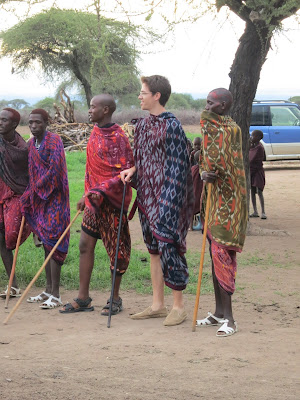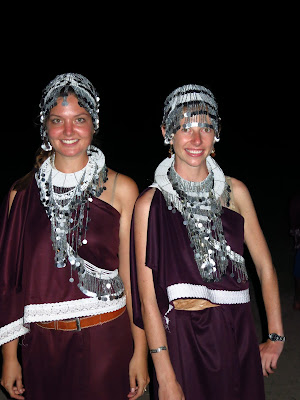A few days ago, this sensation was
heightened for both of us when we found ourselves in the midst of a
Maasai village, taking part in one of their traditional dances. The
Maasai are a group of semi-nomadic, pastoral people who live
throughout Kenya and Tanzania. Despite the influence of the outside
world and pressure from both the Kenyan and Tanzanian governments to
abandon their traditional lifestyle, many Maasai live lives that are
strikingly similar to those of their ancestors. Deborah's husband,
Putiyei, is a Maasai, and a few nights ago we were invited to the nearby village where his family lives to witness and join in one of their
dances.
I should note that I use the term
“nearby” liberally. The journey out to this village was quite
long and involved. We walked down to the main road and took a
45-minute dala-dala ride to another town. We then piled onto several
piki-pikis and took an often-harrowing ride on a pothole-ridden,
muddy, bumpy dirt road to another, even more remote village. Jenna,
myself and some others were lucky enough at this point to catch a
ride in Putiyei's 4-wheel-drive for the remainder of the journey (in
which we came very close to becoming hopelessly stuck in a giant mud
puddle created by a recent heavy rain). The rest of our group had to
walk for almost 2 hours to reach our destination—the village of
Soluwaya.
We were greeted by friendly smiles and
timid but playful groups of children. We took a brief tour of the
village and were kindly invited into multiple surprisingly modern and
well-furnished homes, where we sat smiling and shifting in somewhat
awkward silence. Putiyei wasn't with us to translate, and none of
those present were even close to conversational in either Swahili or
Maa (their tribal language).
When the dance participants began to
gather, we were invited to join in. The dancers were to be a group
of so-called Moran (the Maasai's term for young men, generally
between 18-30) and young women (some very young). I was ushered into
a private room where I could change, and Kashu, Putiyei's brother,
handed me a set of robes, a “cattle stick” and a long knife in a
sheath. After donning this strange garb, I set off with Kashu to
begin the procession that heralds the beginning of the dance. I
found my place in line, and started off with the group.
As we marched, grunts, shrieks and
other strange sounds emanated from the procession, sounds I would
never have guessed a human could produce. A young girl directly
behind me stifled giggles at the bespectacled, gangly white man in
front of her, and I really couldn't blame her. I was finding it hard
not to break out into laughter myself.
When we reached the place where the
dance would begin, the Moran and the young women (actually only a few
who I would have judged to be old enough to call “women”)
separated themselves and formed two arcs opposite from each other.
The men then began to grunt and wheeze, creating a rhythm and a
droning, continuous tone. The dance was relatively simple,
consisting of many variations of the same theme—a man from the
group would sing a high-pitched string of words, and was in turn
responded to by the group. Occasionally the women and girls would join in, punctuating the men's chants with soft, lullaby-like singing, but mostly, the songs and dance were led by the Moran. The chanting would begin, and the men
would take turns stepping out of line and jumping as high as they
could, keeping time with the chant. The technique—which I found to
be incredibly difficult—was to keep one's entire body rigidly
straight and launch into the air, using the calf muscles while
bending at the knees as little as possible.
This phase of the dance would last
anywhere from 10 minutes to a half hour, after which the women would
get involved. They would step forward, towards the men, and shake
their upper body in such a way as to rattle the beads and metal of
their ornate collar-necklaces as loudly as possible, while still keeping their body as still as possible . I was happy to see that Jenna, too,
was dressed in traditional garb and was participating with the young
women and other volunteers. The men would dance around them,
interacting with subtle gesticulations and more strange sounds.
The dance lasted for hours, and
the longer the chanting and jumping lasted, the more relaxed the
group became, the more willing to improvise and forget rules and
inhibitions. We fed off this energy, and found ourselves dancing
with them well past dark.
My throat ached, raw from the grunting; my
legs burned, but I continued nonetheless, until finally Putiyei
approached and told me that dinner was ready. Thankful for the
reprieve, I stepped out of line and left the group of dancers. They
continued for at least another hour, and Jenna and I could hear their
music even as we lay in bed after dinner.
In the morning, after breakfast, some of the women from the village brought out some of their beautiful, handcrafted, jingling jewelry and offered it to us to buy. The volunteers passed around necklace after beaded necklace, debating which ones they preferred and negotiating prices. We couldn't believe the bargains we were getting on such incredible pieces, all of which must have taken many hours of dedicated and practiced work to make.
When we completed the jewelry negotiations, we thanked the villagers for hosting us and for including us in their unique tradition. We then set off down the road, beginning our nearly two hour walk back to the village we had passed through on the previous day. As we walked away, we reflected on our experience, marveling at the beauty and distinctiveness of it all, and contemplating the likelihood of us ever participating in such a ceremony again.
 |
| Us with Kashu, taking a quick break from dancing to snap a pic |
In the morning, after breakfast, some of the women from the village brought out some of their beautiful, handcrafted, jingling jewelry and offered it to us to buy. The volunteers passed around necklace after beaded necklace, debating which ones they preferred and negotiating prices. We couldn't believe the bargains we were getting on such incredible pieces, all of which must have taken many hours of dedicated and practiced work to make.
 |
| The female volunteers, admiring the jewelry and deliberating which to purchase |
When we completed the jewelry negotiations, we thanked the villagers for hosting us and for including us in their unique tradition. We then set off down the road, beginning our nearly two hour walk back to the village we had passed through on the previous day. As we walked away, we reflected on our experience, marveling at the beauty and distinctiveness of it all, and contemplating the likelihood of us ever participating in such a ceremony again.
 |
| A beautiful Maasai girl, still wearing her dress from the night before |
 |
| Deb and Putiyei's daughter, Serianne, all decked out in her Maasai finest |








No comments:
Post a Comment